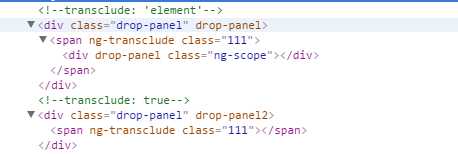标签:
我们使用ng的时候,经常会使用到指令,大家所熟知的属性我在这里就不介绍了,讲讲大家没怎么留意的属性
1.multiElement
这是指定指令作用区间的功能,最常用的就是ng-repeat-start和ng-repeat-end了。
2.priority
指令优先级,优先级越高,指令越早执行。
3.terminal
是否允许优先级低的指令起作用,如果是true,那么只有比当前指令或跟当前指令等级相同的指令才可以执行。最典型的就是ngIf
4.templateNamespace
声明模板的格式有三种选择 svg、html、math
5.transclude
或许有人疑问了,transclude也算是冷门属性吗?其实大家对transclude了解并没有想象的那么深,transclude是一个挺复杂的属性,一般大家会用到的也仅仅是true,false。这两个属性我在这里就不讲了,在这里我主要讲的是transclude:element,我google了一整天都没找到正确描述这个属性的方法。我觉得google出来的答案太文档化了。最后在研究$transclude才看出来这个属性的功能究竟在哪里。再讲功能前我们先了解下$transclude
无论在指令的compile还是link时期我们的最后一个参数就是$transclude了,这里其实我们看看源码是如何定义的,我看的源码是ng1.5.3的
function controllersBoundTransclude(scope, cloneAttachFn, futureParentElement, slotName) { var transcludeControllers; // No scope passed in: if (!isScope(scope)) { slotName = futureParentElement; futureParentElement = cloneAttachFn; cloneAttachFn = scope; scope = undefined; } if (hasElementTranscludeDirective) { transcludeControllers = elementControllers; } if (!futureParentElement) { futureParentElement = hasElementTranscludeDirective ? $element.parent() : $element; } if (slotName) { // slotTranscludeFn can be one of three things: // * a transclude function - a filled slot // * `null` - an optional slot that was not filled // * `undefined` - a slot that was not declared (i.e. invalid) var slotTranscludeFn = boundTranscludeFn.$$slots[slotName]; if (slotTranscludeFn) { return slotTranscludeFn(scope, cloneAttachFn, transcludeControllers, futureParentElement, scopeToChild); } else if (isUndefined(slotTranscludeFn)) { throw $compileMinErr(‘noslot‘, ‘No parent directive that requires a transclusion with slot name "{0}". ‘ + ‘Element: {1}‘, slotName, startingTag($element)); } } else { return boundTranscludeFn(scope, cloneAttachFn, transcludeControllers, futureParentElement, scopeToChild); } }
还有一个另一个函数要特别指出来,就是最后返回的 boundTranscludeFn 这个方法,下面是他的源码
function createBoundTranscludeFn(scope, transcludeFn, previousBoundTranscludeFn) { function boundTranscludeFn(transcludedScope, cloneFn, controllers, futureParentElement, containingScope) { if (!transcludedScope) { transcludedScope = scope.$new(false, containingScope); transcludedScope.$$transcluded = true; } return transcludeFn(transcludedScope, cloneFn, { parentBoundTranscludeFn: previousBoundTranscludeFn, transcludeControllers: controllers, futureParentElement: futureParentElement }); }
这两个方法到底是在做什么呢?其实就是克隆了当前指令的节点,并生成子作用域。克隆的节点由transclude定义,如果你的属性是true,则克隆的是指令模板中的ng-transclude所在的DOM节点,及其子节点。如果属性是element则克隆整个模板的节点。
这是两个指令的代码
angular.module(‘MyApp‘, []) .directive(‘dropPanel‘, function() { return { transclude: ‘element‘, replace: true, template: "<div class=‘drop-panel‘>" + "<span ng-transclude class=‘111‘></span>" + "</div>", link: function(scope, el, c, d, $transclude) { $transclude(function ngRepeatTransclude(clone, scope) { console.log(clone); }) } } }) .directive(‘dropPanel2‘, function() { return { transclude: true, replace: true, template: "<div class=‘drop-panel‘>" + "<span ng-transclude class=‘111‘></span>" + "</div>", link: function(scope, el, c, d, $transclude) { $transclude(function ngRepeatTransclude(clone, scope) { console.log(clone); }) } } })
如果你觉得replace干扰了对结果的理解,你可以注释掉,然后查看控制台中打印出来的clone,你就能知道所谓transclude的属性声明为element的作用了,我们打开replace目的在于能较清楚的查看DOM节点,来获得结论,下面就是两者编译后DOM节点的区别了

看完上面的图,你可以明显的区别到两者对DOM的克隆不一样的,另外如果在声明属性为‘element’时,需要声明replace为true,才能渲染出来。我查了很多资料,但是还是没能力为大家解答这个问题,断点追踪的结果是发现如果不声明replace,好像就不会执行ngTransclude指令,这点我很奇怪,正因为这样子所以导致没有成功选人。但是我看到一个观点觉得不错,大概意思就是:源于功能的考虑,在使用element属性的时候,一般都是起占位符的作用,你需要做的操作是对DOM的添加时候,才会用到这个克隆功能。
我觉得这个观点不错,看过很多关于ngrepeat的介绍,很多文章都说ngrepeat源码是通过$scope.$new()来生成子作用域的,实际上并不完全正确,他的确是通过$scope.$new产生子作用域的,但是这个产生功能是交给$transclude函数去做得,实际上ngrepeat的源码上是通过$transclude来生成子作用域和添加DOM节点的。与上面的观点有相似之处。
就讲到这里了,这是作者原创,转载请注明
标签:
原文地址:http://www.cnblogs.com/HeJason/p/5514690.html